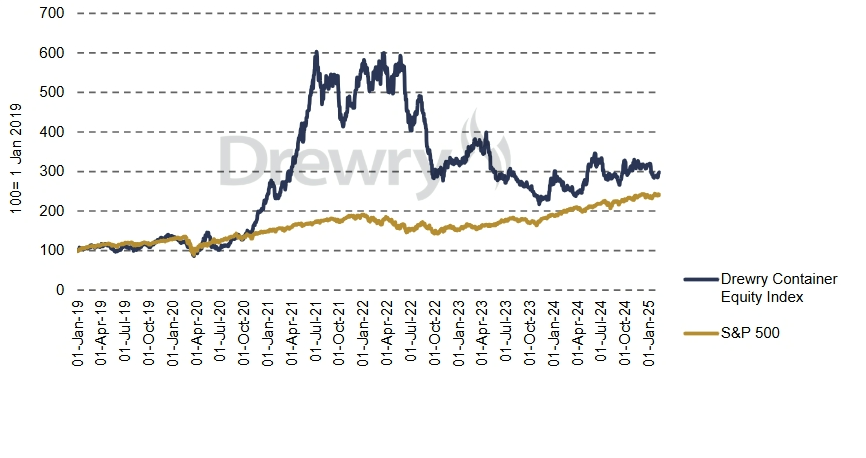The past few years have seen container shipping stocks fluctuate as wildly as the ocean waves they navigate. The journey has been risky and volatile, yet the returns have been remarkable.
An investor who placed $1,000 into companies tracked by Drewry Maritime Financial Research’s Container Equity Index at the start of 2019 would have seen their investment more than triple to approximately $3,150 as of February 10, 2025. By comparison, the same investment in the S&P 500 would now be worth about $2,346.
This extraordinary performance was driven by extraordinary events. As the saying goes, “opportunity arises in crisis,” and it was the COVID-19 pandemic—along with the resulting supply chain turmoil—that propelled container shipping stocks into a meteoric rise from November 2020 through May 2022. However, since then, the market has experienced a steep decline, with the Container Equity Index now down 50% from its peak.
A perfectly timed investor with the ability to buy and sell at optimal moments could have turned that initial $1,000 into an astonishing $6,034—a 500% return in just over six months. But that raises the question: if they had such foresight, why stop at $1,000?
The key takeaway is that liner stocks remain highly sensitive to global events and external disruptions. They have demonstrated their ability to serve as a lucrative hedge against broader market downturns during crises, but their value tends to erode when stability returns.
Given this, one might wonder how investors and stakeholders feel about the imminent full-scale resumption of Suez Canal transits. Similarly, could some be quietly hoping for increased trade disruptions due to Donald Trump’s tariff policies?
While we cannot predict the future like our hypothetical time-traveling investor, Drewry sought to gauge industry sentiment by surveying stakeholders across the shipping sector. The survey focused on two major developments: the expected timeline for Suez Canal operations to normalize and the potential impact of Trump’s trade policies.
However, the rapid pace of today’s news cycle meant that two of our questions were answered before we could even finalize the survey. Specifically, respondents were asked whether they believed President Trump would introduce new tariffs in his second term and, if so, when. Unsurprisingly, after the U.S. announced fresh tariffs on China while delaying planned levies on Canada and Mexico, 300 respondents checked “Yes” and “2025.”
Beyond confirming the inevitability of tariff increases, the remaining survey responses offer valuable insights into the potential scale of these policies. They shed light on which countries might still be in Trump’s crosshairs and the overall percentage of U.S. imports that could be impacted.
As the shipping industry braces for these developments, one thing remains clear: volatility isn’t going anywhere. For investors and stakeholders alike, staying ahead of global disruptions will continue to be both a challenge and an opportunity.




